2014 PEUGEOT PARTNER check engine
[x] Cancel search: check enginePage 113 of 244
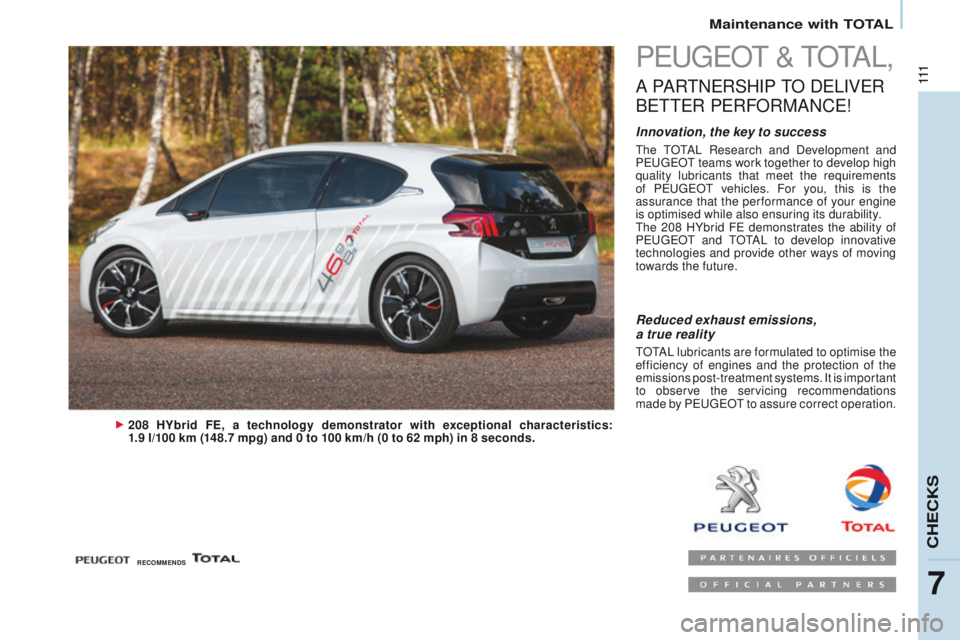
111111
Partner-2-VU_en_Chap07_Verification_ed02-2014
PEUGEOT & TOTAL,
A PARTNERSHIP TO DELIVER
B
ETTER
PERFORMANCE
!
Innovation, the key to success
The TOTAL Research and Development and
PEUGEOT teams work together to develop high
quality lubricants that meet the requirements
of PEUGEOT vehicles. For you, this is the
assurance that the performance of your engine
is optimised while also ensuring its durability.
The 208 HYbrid FE demonstrates the ability of
PEUGEOT and TOTAL to develop innovative
technologies and provide other ways of moving
towards the future.
208 HYbrid FE, a technology demonstrator with exceptional characteristics:
1.9 l/100 km (148.7 mpg) and 0 to 100 km/h (0 to 62 mph) in 8 seconds.
Reduced exhaust emissions,
a true reality
TOTAL lubricants are formulated to optimise the
efficiency of engines and the protection of the
emissions post-treatment systems. It is important
to observe the servicing recommendations
made by PEUGEOT to assure correct operation.
RECOMMENDS
CHECKS
7
Maintenance with TOTAL
CHECKS
7
Page 115 of 244
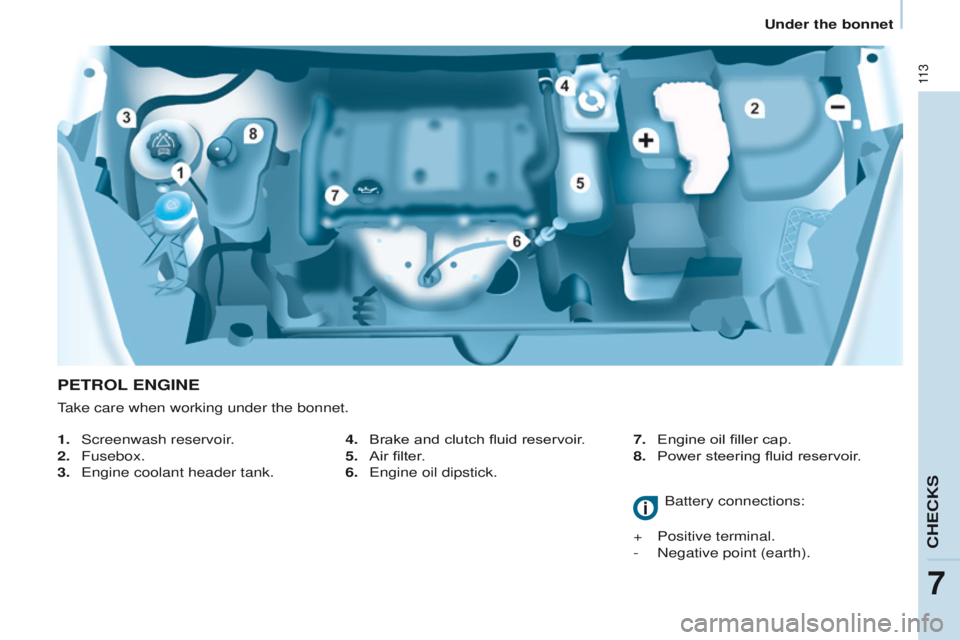
11 3
Partner-2-VU_en_Chap07_Verification_ed02-2014
PETROL ENGINE
1. Screenwash reservoir.
2.
Fusebox.
3.
Engine coolant header tank. Battery connections:
+
Positive terminal.
-
Negative point (earth).
T
ake care when working under the bonnet.
4. Brake and clutch fluid reservoir .
5.
Air filter
.
6.
Engine oil dipstick.7.
Engine oil filler cap.
8.
Power steering fluid reservoir
.
CHECKS
7
Under the bonnet
Page 117 of 244
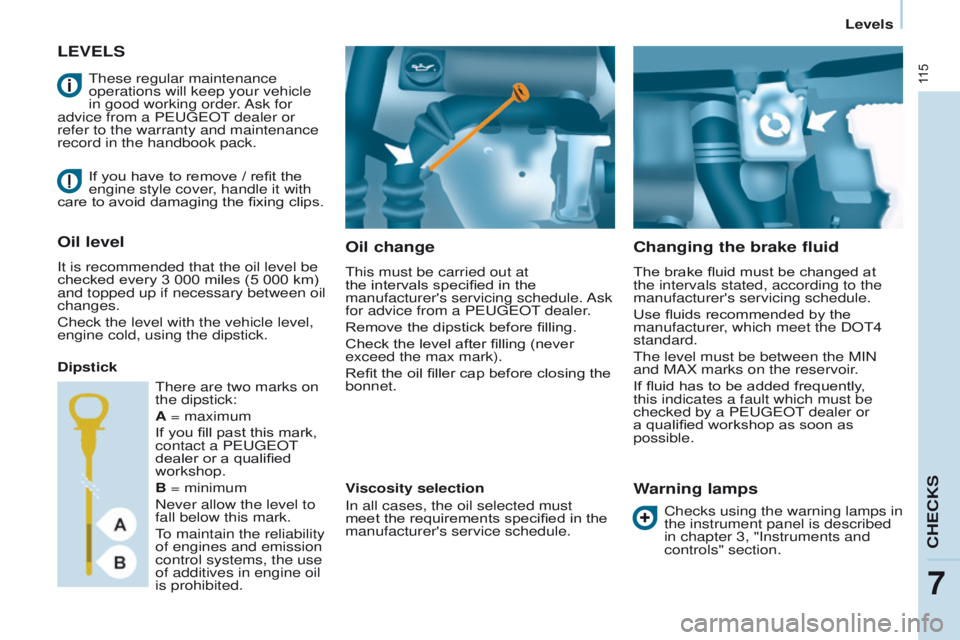
11 5
Partner-2-VU_en_Chap07_Verification_ed02-2014
LEVELSOil change
This must be carried out at
the intervals specified in the
manufacturer's servicing schedule. Ask
for advice from a PEUGEOT dealer.
Remove the dipstick before filling.
Check the level after filling (never
exceed the max mark).
Refit the oil filler cap before closing the
bonnet.
Changing the brake fluid
The brake fluid must be changed at
the intervals stated, according to the
manufacturer's servicing schedule.
Use fluids recommended by the
manufacturer, which meet the DOT4
standard.
The level must be between the MIN
and MAX marks on the reservoir.
If fluid has to be added frequently,
this indicates a fault which must be
checked by a PEUGEOT dealer or
a qualified workshop as soon as
possible.
Warning lamps
If you have to remove / refit the
engine style cover, handle it with
care to avoid damaging the fixing clips.
Oil level
It is recommended that the oil level be
checked every 3 000 miles (5 000 km)
and topped up if necessary between oil
changes.
Check the level with the vehicle level,
engine cold, using the dipstick.
Dipstick
Viscosity selection
In all cases, the oil selected must
meet the requirements specified in the
manufacturer's service schedule.
These regular maintenance
operations will keep your vehicle
in good working order. Ask for
advice from a PEUGEOT dealer or
refer to the warranty and maintenance
record in the handbook pack.
Checks using the warning lamps in
the instrument panel is described
in chapter 3, "Instruments and
controls" section.
There are two marks on
the dipstick:
A = maximum
If you fill past this mark,
contact a PEUGEOT
dealer or a qualified
workshop.
B = minimum
Never allow the level to
fall below this mark.
To maintain the reliability
of engines and emission
control systems, the use
of additives in engine oil
is prohibited.
CHECKS
7
Levels
Page 118 of 244

11 6
Partner-2-VU_en_Chap07_Verification_ed02-2014
Cooling system
Only use the fluid recommended by the
manufacturer.
Otherwise, you risk seriously damaging
your engine.
When the engine is warm, the
temperature of the coolant is controlled
by the engine fan. As this fan can
operate with the ignition key removed
and because the cooling system is
pressurised, wait for at least one hour
after the engine has stopped before
carrying out any work.
Slacken the cap by 1/4 of a turn to
release the pressure to prevent any
risk of scalding. When the pressure
has dropped, remove the cap and top
up the level with coolant.
If fluid has to be added frequently,
this indicates a fault which must be
checked by a PEUGEOT dealer as
soon as possible.
Power steering fluid level
The vehicle must be parked on level
ground with the engine cold. Unscrew
the cap integrated with the gauge and
check the level which must be between
the MIN and MAX marks.In order to regenerate the filter, you
are advised to drive at a speed higher
than 40 mph (60 km/h) for at least five
minutes as soon as possible, when
traffic conditions permit (until the
message disappears and the service
warning lamp goes off).
During regeneration of the particle
emission filter, the noise of a relay
operating may be heard under the
dashboard.
If the message is still displayed and
if the service warning lamp remains
on, contact a PEUGEOT dealer or a
qualified workshop.
Topping up
The level must be between the MIN
and MAX marks on the expansion
bottle. If more than 1 litre of fluid is
required to top up the level, have
the system checked by a PEUGEOT
dealer or a qualified workshop.
Screenwash and headlamp
wash level
For best quality cleaning and for your
safety, we would advise that you use
products of the PEUGEOT range.
For optimum cleaning and to avoid
freezing, this fluid must not be topped
up or replaced with plain water.
Capacity of the screenwash reservoir:
approximately 3 litres.
If your vehicle is fitted with headlamp
washers, the capacity of the reservoir
is 6 litres.
Diesel additive level
(Diesel with particle
emission filter)
Topping up
This additive must be topped up by
a PEUGEOT dealer or a qualified
workshop without delay.
Waste products
Avoid prolonged contact of used oil
with the skin.
Brake fluid is harmful to health and
very corrosive.
Do not dispose of used oil, brake fluid
or coolant into drains or into the ground
but into the containers dedicated to this
use at a PEUGEOT dealer (France) or
an authorised waste disposal site.
The minimum level of this additive
is indicated by lighting of the service
warning lamp, accompanied by an
audible signal and a message in the
screen.
When this occurs with the engine
running it is due to the start of
saturation of the particle emission filter
(exceptionally prolonged urban type
driving conditions: low speed, long
traffic jams, ...).
Levels
Page 120 of 244

11 8
Partner-2-VU_en_Chap07_Verification_ed02-2014
Bleeding water from the Diesel
filterManual gearbox
Have the level checked in accordance with
the manufacturer's servicing schedule.
Only use products recommended
by PEUGEOT or products
of equivalent quality and
specification.
In order to optimise the operation
of units as important as the braking
system, PEUGEOT selects and offers
specific products.
In order to avoid damaging the
electrical units, high pressure washing
to clean the engine compartment is
strictly prohibited.
After washing the vehicle dampness,
or in winter, ice may form on the brake
discs and pads: braking efficiency may
be reduced. Make some light brake
applications to dry and de-ice the
brakes.
If this warning lamp comes
on, bleed the filter. Otherwise
bleed regularly each time the
engine oil is changed.
To drain the water, unscrew the bleed
screw located on the filter.
Operate until all of the water no longer
flows in the transparent pipe, then
tighten the bleed screw.
Particle filter (Diesel)
Maintenance of the particle filter must
be carried out by a PEUGEOT dealer.
On acceleration after the vehicle has
been running for a prolonged period
at very low speed or at idle, you may,
in exceptional circumstances, notice
the emission of water vapour at the
exhaust. This water vapour does not
have any adverse effect on vehicle
handling or the environment.
Oil filter
Change the filter regularly in
accordance with the manufacturer's
servicing schedule.
HDi engines use advanced
technology. All work requires
special training, which is assured
by a PEUGEOT dealer.
Depending on country of sale.
Checks
Page 121 of 244

11 9
Partner-2-VU_en_Chap07_Verification_ed02-2014
FILLING WITH FUEL
Low fuel level
Filling
The fuel tank must be filled with the
engine off.
-
Open the fuel filler flap.
-
Insert the key
, then turn it a quarter
turn.
-
Remove the cap and hook it onto
the clip located on the inside of the
flap.
When fillin
g with fuel, with the fuel
filler flap open, ensure that no one
attempts to open the sliding side
door.
When the minimum fuel tank
level is reached, this warning
lamp comes on.
You then have approximately 8 litres
of fuel remaining. Fill up without delay
to avoid running out of fuel.
Never risk driving until you run out of
fuel as this may damage the emissions
control and injection systems.Fuel used for petrol engines
A label affixed to the inside of the flap
reminds you of the type of fuel to be
used.
You must fill with at least 5 litres of fuel
for it to be registered by the fuel gauge.
When the fuel filler cap is opened,
there may be a slight air suction noise.
This vacuum is entirely normal and is
due to the sealing of the fuel circuit.
When filling the fuel tank, do not
continue after the 3
rd cut-off of the
nozzle. This could cause malfunctions.
The capacity of the fuel tank is
approximately 60 litres.
-
After fillin
g the fuel tank, lock the
cap and close the flap. The petrol engines are compatible
with E10 bio-petrol (containing
10
% ethanol), conforming to European
standards EN 228 and EN 15376.
E85 type fuels (containing up to
85 % ethanol) are reserved exclusively
for vehicles marketed for the use of
this type of fuel (BioFlex vehicles). The
quality of the ethanol must comply with
European standard EN 15293.
CHECKS
7
Fuel
Page 122 of 244
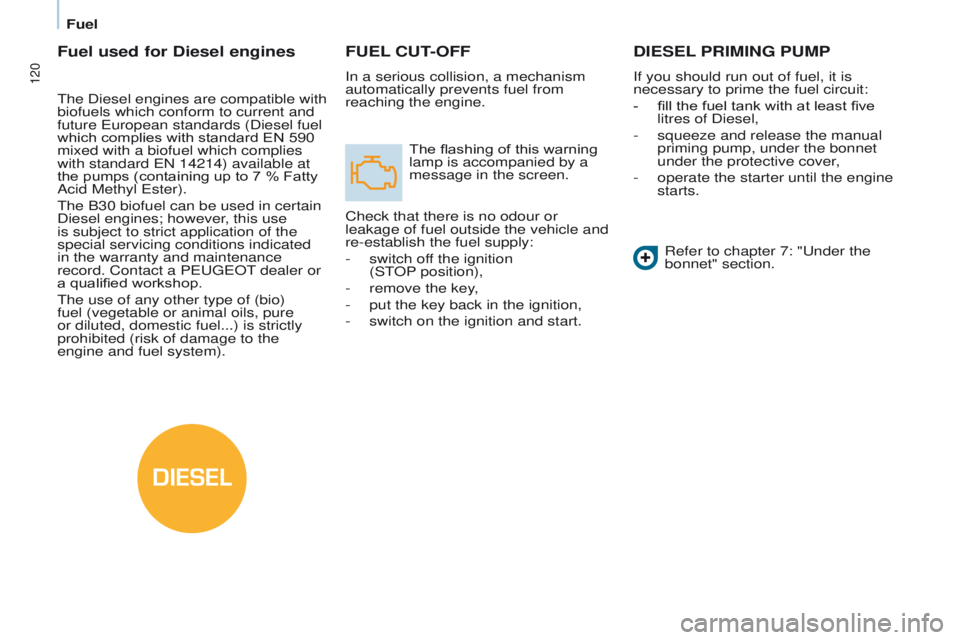
DIESEL
120
Partner-2-VU_en_Chap07_Verification_ed02-2014
FUEL CUT-OFF
In a serious collision, a mechanism
automatically prevents fuel from
reaching the engine.The flashing of this warning
lamp is accompanied by a
message in the screen.
Check that there is no odour or
leakage of fuel outside the vehicle and
re-establish the fuel supply:
-
switch of
f the ignition
(STOP
position),
-
remove the key
,
-
put the key back in the ignition,
-
switch on the ignition and start.
DIESEL PRIMING PUMP
If you should run out of fuel, it is
necessary to prime the fuel circuit:
-
fill the fuel tank with at least five
litres of Diesel,
-
squeeze and release the manual
priming pump, under the bonnet
under the protective cover
,
-
operate the starter until the engine
starts. Refer to chapter 7: "Under the
bonnet" section.
Fuel used for Diesel engines
The Diesel engines are compatible with
biofuels which conform to current and
future European standards (Diesel fuel
which complies with standard EN 590
mixed with a biofuel which complies
with standard EN 14214) available at
the pumps (containing up to 7 % Fatty
Acid Methyl Ester).
The B30 biofuel can be used in certain
Diesel engines; however, this use
is subject to strict application of the
special servicing conditions indicated
in the warranty and maintenance
record. Contact a PEUGEOT dealer or
a qualified workshop.
The use of any other type of (bio)
fuel (vegetable or animal oils, pure
or diluted, domestic fuel...) is strictly
prohibited (risk of damage to the
engine and fuel system).
Fuel
Page 123 of 244
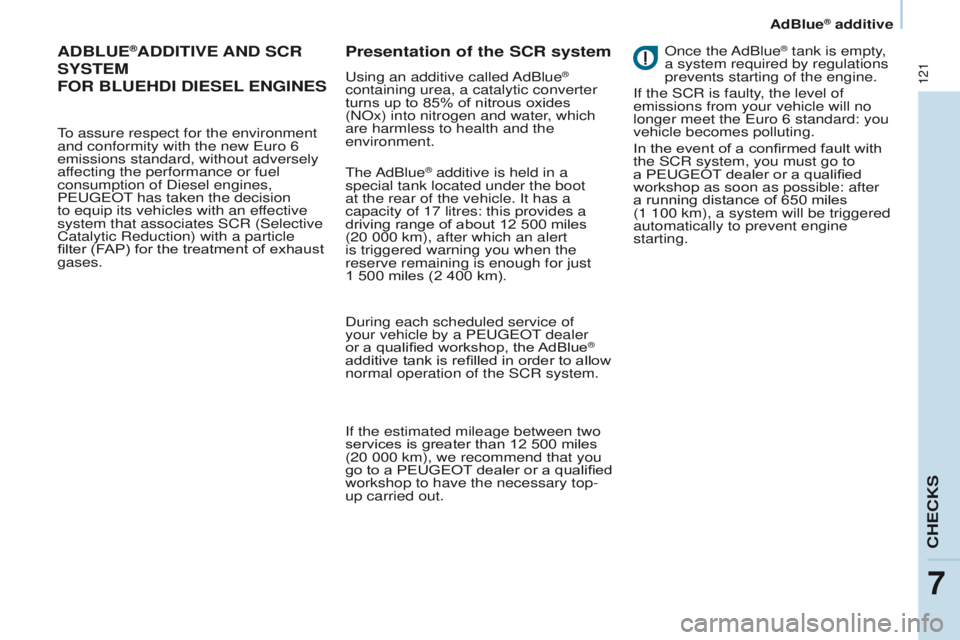
121
Partner-2-VU_en_Chap07_Verification_ed02-2014
ADBLUE®ADDITIVE AND SCR
SYSTEM
FOR
B
LUE HD I D IESEL
ENGINES
To assure respect for the environment
and conformity with the new Euro 6
emissions standard, without adversely
affecting the performance or fuel
consumption of Diesel engines,
PEUGEOT has taken the decision
to equip its vehicles with an effective
system that associates SCR (Selective
Catalytic Reduction) with a particle
filter (FAP) for the treatment of exhaust
gases.
Presentation of the SCR system
Using an additive called AdBlue®
containing urea, a catalytic converter
turns up to 85% of nitrous oxides
(NOx) into nitrogen and water, which
are harmless to health and the
environment.
The AdBlue
® additive is held in a
special tank located under the boot
at the rear of the vehicle. It has a
capacity of 17 litres: this provides a
driving range of about 12 500 miles
(20
000
km), after which an alert
is triggered warning you when the
reserve remaining is enough for just
1
500 miles (2 400 km).
During each scheduled service of
your vehicle by a PEUGEOT dealer
or a qualified workshop, the AdBlue
®
additive tank is refilled in order to allow
normal operation of the SCR system.
If the estimated mileage between two
services is greater than 12 500 miles
(20 000 km), we recommend that you
go to a PEUGEOT dealer or a qualified
workshop to have the necessary top-
up carried out. Once the AdBlue
® tank is empty,
a system required by regulations
prevents starting of the engine.
If the SCR
is faulty, the level of
emissions from your vehicle will no
longer meet the Euro 6 standard: you
vehicle becomes polluting.
In the event of a confirmed fault with
the SCR system, you must go to
a PEUGEOT dealer or a qualified
workshop as soon as possible: after
a running distance of 650 miles
(1
100 km), a system will be triggered
automatically to prevent engine
starting.
CHECKS
7
AdBlue® additive